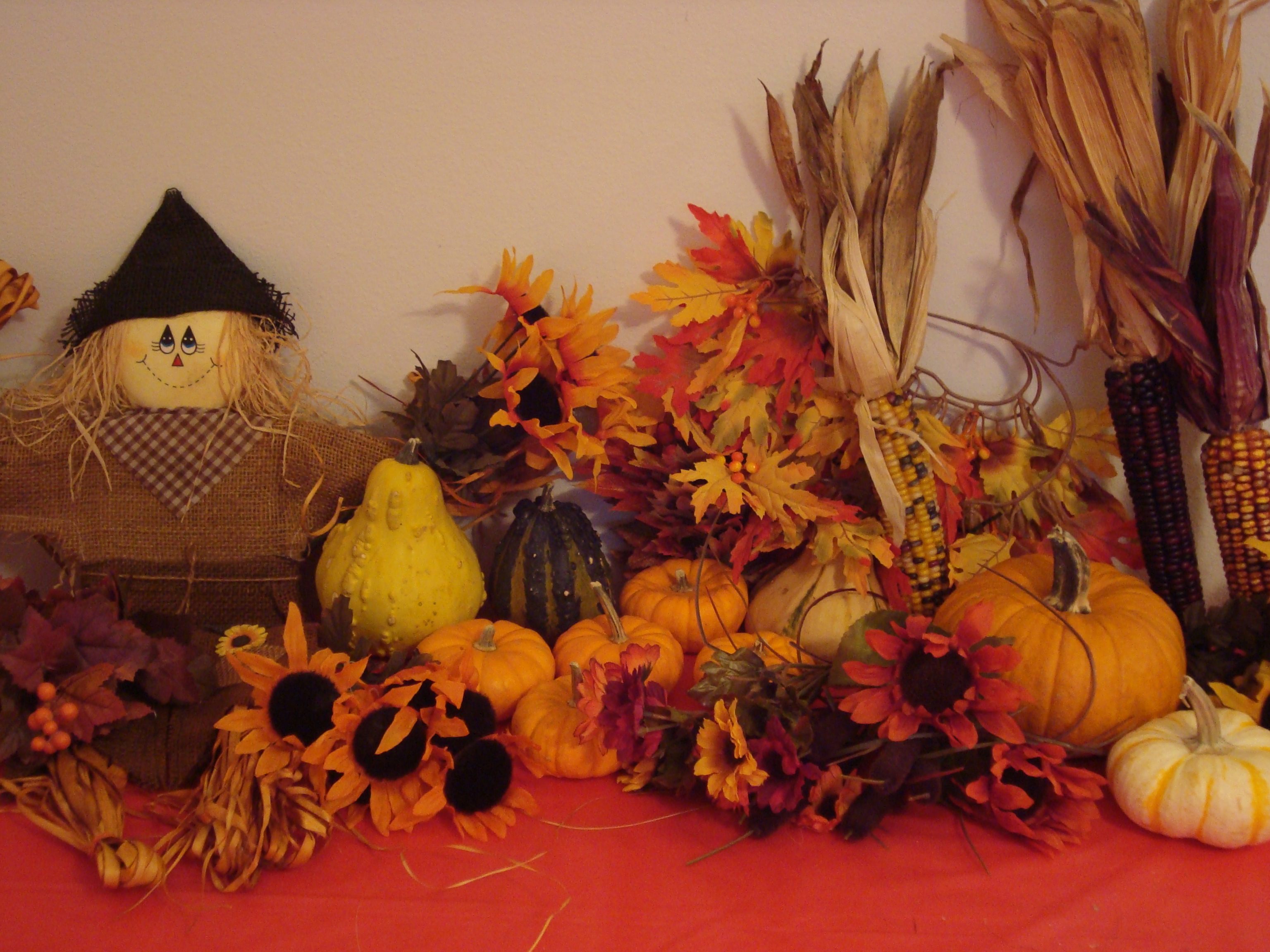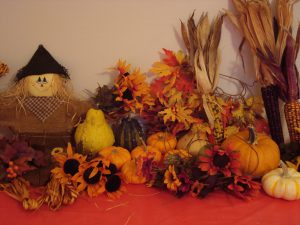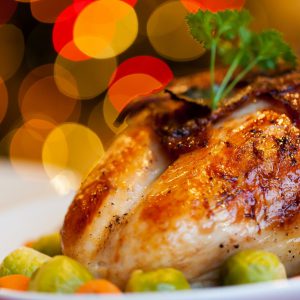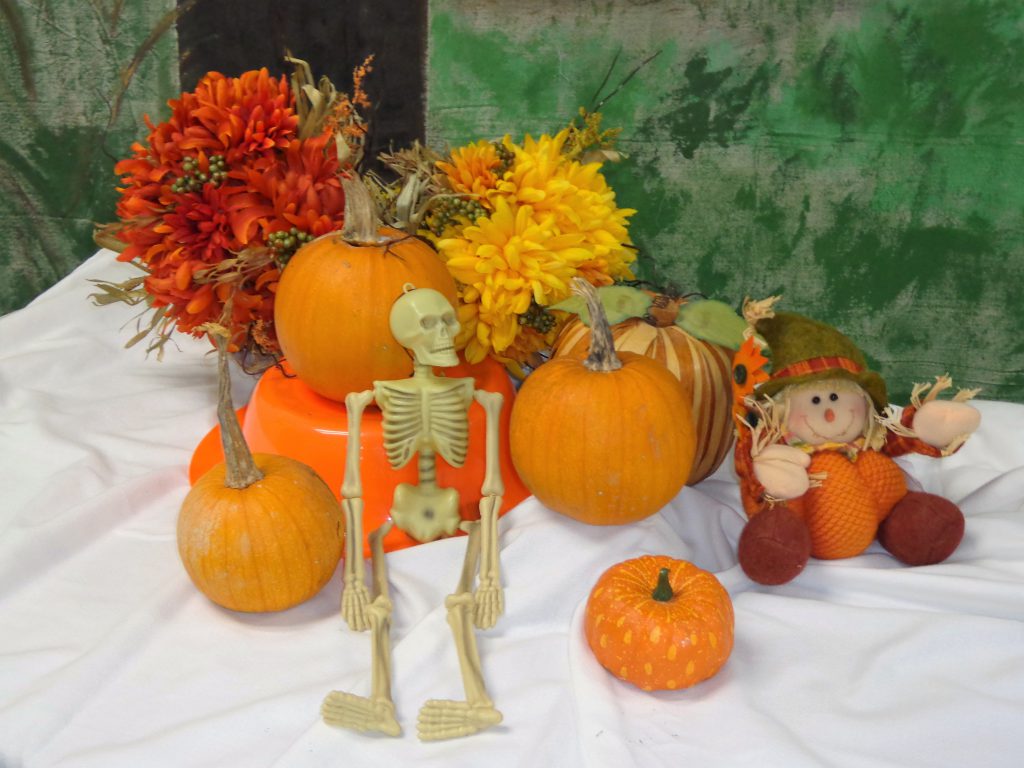
by Angela Hinkle | Oct 27, 2017

Favorite Fall Things
Photo Credit: Angela Hinkle
Fall is my favorite time of year. Let me share with you a few of my favorite Fall things to help explain why.
- Walking my dog in the heat of a summer morning is like trudging through a bowl of warm chowder. But with the cooler autumn mornings arriving, we become invigorated and feel like taking longer walks to add steps to the pedometer on my hip. Let’s hear it for more physical activity! For walking tips, check out cdc walking counts.
- Just think about all of those yummy, nutrient-dense foods available this time of year – peanuts, sweet potatoes, and squashes and gourds in a variety of shapes, colors, and sizes. See Florida Panhandle Produce in Season for seasonal produce in the Florida Panhandle.
- Okay, so leaves don’t really change color a whole lot when fall weather hits the panhandle of Florida. But I have this great tree outside my office window. My horticulture agent says it’s a Bald Cypress. This time of year, I get to see it change leaf colors from green, to golden yellow, to burnt orange. Simply beautiful. Look around your neighborhood to see what bounty of colors you can find.
- Though you will not find me wearing any shade of orange or deep yellow (those are definitely not in my color palette), I do cherish all the oranges, deep reds, purples, and yellows found in the flowers, pumpkins, scarecrows, and decorative corn stalks. Perk up your area with some fall color. Dollar stores have lots to pick and choose from.
- I’ve had my DNA tested. I am, in fact, 41% Sicilian. My holidays can therefore start with Columbus Day, work their way through the fun of Halloween, the respectful honors of Veteran’s Day, and through Thanksgiving with a myriad of Fall Harvest Celebrations sprinkled in between.
To get you in the Fall mood, try this simmering potpourri recipe. Let me know if you like it and be sure to share with family and friends some of your favorite fall things.
Favorite Fall Stovetop Potpourri
Add any or all of the following ingredients to a small pot: ground cinnamon, cinnamon sticks, orange peelings, ground ginger, whole cloves, ground cloves, vanilla extract, and almond extract. Add enough water to fill pot to rim. Then put the pot on the stove top at lowest setting. Add more water as necessary. Enjoy!
by Amy Mullins, PhD, RDN | Oct 26, 2017
 We all have family traditions that make our holiday celebrations special. From your great-great-grandma’s sweet potato casserole or pecan pie, to your mother-in-law’s sausage stuffing or decadent plum pudding, there’s one thing that always seems to be a common factor among traditional holiday dishes: a massive amount of, fat, sugar, salt, and calories!
We all have family traditions that make our holiday celebrations special. From your great-great-grandma’s sweet potato casserole or pecan pie, to your mother-in-law’s sausage stuffing or decadent plum pudding, there’s one thing that always seems to be a common factor among traditional holiday dishes: a massive amount of, fat, sugar, salt, and calories!
It’s not only a single meal but rather an entire season of parties, events, gatherings festivities, and unhealthy choices that add up to that holiday weight gain we resolve to lose when January rolls around. As the holiday season begins its rapid approach, take time and consider those past eating habits that set your new year off on the wrong foot. Why not make a resolution now to eat healthier this holiday season?
Just a few simple strategies can help make the difference and keep those unwanted pounds away. Here are some suggestions:
- Don’t skip meals. Eating healthy on a regular basis will keep you from overindulging at holiday gatherings.
- Use smaller plates for meals and gatherings and be mindful of portions
- Choose more vegetables and smaller helpings of entrees and desserts
- Drink more water and minimize alcoholic drinks and eggnog
- Make healthier recipe ingredient substitutions when cooking and baking (Mayo Clinic):
- Instead of heavy cream, use fat free half and half or evaporated skim milk
- Instead of bacon, try Canadian bacon, turkey bacon or smoked turkey
- Decrease sugar in baked goods by half and add vanilla, nutmeg, or cinnamon to intensify sweetness
- Substitute applesauce or prune puree for half of the butter, shortening, or oil
- Use two egg whites or ¼ cup egg substitute for each whole egg
- Replace salt with fresh or dried herbs and spices.
We can all still experience the joy of the holiday season, without making food the focus. Make a resolution to be mindful and eat healthier this holiday season, and your waistline will thank you.
Some additional links that you may find helpful:
https://healthyforgood.heart.org/eat-smart/articles/holidays-healthy-eating-guide
https://www.cdc.gov/features/HealthyResolutions/
https://choosemyplate-prod.azureedge.net/sites/default/files/printablematerials/2013-HolidayMakeover.pdf
https://www.mayoclinic.org/healthy-lifestyle/nutrition-and-healthy-eating/in-depth/healthy-recipes/art-20047195?p=1
by Samantha Kennedy | Oct 26, 2017

Photo credit:
www.Pexels.com (Creative Commons License)
According to the National Turkey Federation, 88% of American families eat turkey on Thanksgiving. That’s over 46 million turkeys! Served as the main dish, it is complemented by a variety of sweet and savory side dishes, many of which are family traditions made from recipes passed down through the generations.
Why do we eat turkey on Thanksgiving, anyway? Well, it’s kind of a funny story. While historians generally agree that turkey wasn’t eaten at the First Thanksgiving in Plymouth in 1621, it was well-documented that settlers often hunted wild turkeys as a source of protein, and subsequent celebrations often included turkey. After President Lincoln declared Thanksgiving a national holiday in 1863, turkey became a staple on many Thanksgiving tables.
When choosing a turkey, there are a few decisions to make. How many people will be eating? Will it be roasted, smoked, or deep-fried? Is frozen or fresh preferred?
When it comes to the proper size, a pound per person is a great rule of thumb. This includes the total weight of the bird, not just the meat. Also, the ratio of white meat to dark meat is about 7:3 (70% white meat, 30% dark), so if there are a lot of dark meat lovers around the table, additional thighs and drumsticks may need to be purchased.
Roasting is the most common way to cook a turkey. This method involves placing the turkey in a large roasting pan and cooking it in the oven slowly over several hours. The turkey is usually placed breast-side up in the pan and basted periodically to prevent drying. The lid or foil is also removed the last 30 to 45 minutes of roasting time to brown the skin and give the turkey that gorgeous presentation.
Vegetables such as potatoes, carrots, or Brussels sprouts may be added to the roasting pan to cook concurrently. For best results, roast the turkey at 325˚F for 15 minutes per pound. For example, a 15 pound turkey would take 3 hours and 45 minutes.
Smoked turkeys are usually fully cooked (read the label to be sure) and just need to be reheated. Keep in mind, smoking is done to impart flavor and does not increase the turkey’s shelf life. Follow the instructions on the package to properly reheat the turkey.
Deep-fried turkeys are submerged in very hot oil and cook more quickly than roasted turkeys. Turkeys can be deep fried in a very large stockpot or in a designated turkey fryer. Only use enough oil to cover the turkey. Too much oil can cause a fire or overflow when the turkey is added to the cooker.
To determine the amount of oil, place the turkey in the cooker and add enough water to cover the bird. Then remove the bird. The water line will indicate the level of oil needed to adequately fry the turkey. For best results, let the turkey warm to room temperature before frying, and fry the turkey for 3 minutes per pound plus 5 minutes per bird.
Remember, the size of the cooker will dictate the size of the turkey. The turkey should fit easily without being forced. Wedging a turkey into a cooker that is too small could cause uneven cooking, or worse, a fire.
As for frozen versus fresh, there is no difference in flavor. However, frozen turkeys can be purchased months in advance and kept frozen until needed. Fresh turkeys should be purchased no more than two days in advance for maximum safety and freshness.
The safest way to thaw a frozen turkey is in the refrigerator. This will take pre-planning. The general rule of thumb is 24 hours of refrigerator thawing per 5 pounds. For example, a 15 pound turkey should take 3 full days (72 hours) to thaw completely.
However the turkey is cooked this year, have a Happy Thanksgiving!
by Melanie Taylor | Dec 5, 2016
As the holiday season quickly approaches many people become overwhelmed with all of the activities, decorating, and shopping that needs to be completed. Here are a few tips to save energy, time and your nerves.
 Let’s begin with 5 Steps to Seasonal Savings:
Let’s begin with 5 Steps to Seasonal Savings:
- Recognize Your Seasonal Stressors: Know your personal stressors—such as family, friends, work, travel, social outings and traditions (both old and new)—then you can be less stressed this holiday season. Marketing ploys sneak into every stressor, and retailers want to ensure they get their piece of the holiday pie by using marketing gimmicks to lure you into shopping with them. Do you find yourself with the overwhelming desire to get everything on your child’s list? If so, consider going without a list or setting limits, and communicate with your child. Often, parents do not involve their children in the holiday spending process. Children need help recognizing when and how they have been targeted and persuaded to want the latest and greatest item. Children also need to understand that a budget is necessary and saying “no” to an overpriced item is okay.
- Develop a Holiday Spending Plan—Make a Budget: Ask yourself: How much have I saved? How much can I save before the holidays? Am I comfortable creating debt? Am I comfortable saying “no”?Start with knowing how much you can spend and create a spending plan, which is critical for successful money management for the holidays and all year long. A few dollars from your paycheck each week adds up quickly over a year. You can also take advantage of weekly automatic transfers into your bank account, or join a holiday savings club at a local credit union. If your holiday budget shows you are spending more money than you have, then you’ll likely take on debt. If this is the case, you should also create a plan for paying off purchases made with credit. Prioritize your purchases and consider omitting purchases that require taking on debt.
- Develop a Holiday Spending Plan—Create a List and Stick to It: Make sure you have a list of everyone you plan to buy for during the holidays and of other additional expenses. Decorations, cards, postage, gift wrap, food/entertainment, and travel are additional costs that can drastically impact the holiday budget. Don’t forget to use catalogs, internet surfing for comparison shopping, and barcode scanning apps. Shopping online also limits impulse purchases, and it allows you to avoid long lines, huge crowds, and the lure to eat out while shopping. Be sure to use coupons whenever possible, and be sure to take advantage of the year-end sales. Once you’ve researched and set your budget, you’re ready to start shopping.
- Alternatives to Pricey Presents: If you have a large family, start by thinking outside the box. Consider a gift exchange by drawing names from a hat, which can allow you to put more thought than money into selecting a single gift. You can also buy a single gift for an entire family—perhaps an entertainment basket filled with DVDs and microwave popcorn. Oftentimes, thoughtful and more creative gifts can come from shopping with local businesses. Locally grown fruits and vegetables, honey, or an item from a local artist are just a few suggestions of local products. If you are feeling crafty, then you could make and give holiday arrangements such as centerpieces and decorations. Another idea for the holidays is to donate to a charity in someone’s name instead of gift giving. You can even take the idea of giving to charity to your office. Pool money you would have spent on gifts with your participating colleagues, draw a colleague’s name, and donate the money to a charity of his or her choice. Another gift idea for close friends and/or family is the “gift of time.” Create a coupon book or certificate that gives a loved one the gift of your time (a specific chore, a trip to the park, babysitting, slumber party for the kids).
- Fine-Tuning Your Financials: Use cash and/or debit cards when at all possible. Money coming directly out of your pocket will likely make you think harder about your purchase. If you are going to use a credit card, make sure you have a plan in place to pay it off when the bill is due. You also need to understand the allure of paying with credit. When you’re not paying with “real” money, your buying can easily get out of control, and the shopping process may not seem as painful in that moment. It may be appropriate to tell your older children how much they each have in the budget for holiday spending. When the family is on the same page, it can alleviate some stress. Refocus your family’s thoughts from the material goods to the real meaning of giving and receiving. Knowing your specific situation, making informed decisions, and communicating with loved ones can reduce the effects of holiday stressors.
Let’s take a look at some affordable and DIY Christmas gifts that will be truly appreciated by the recipient.
For the gardener in your life:
Terrarium Kit
Materials:
- One – 3 1/2″ x 7″ canning jar with top
- Small stones (enough to fill 1 inch in jar) You can buy pretty river rocks at your local garden shop or just collect some stones outside.
- A few tablespoons of activated charcoal (found at any pet store’s aquarium section)
- 1 small Ziploc bag
- 3 1/2″ x 5 1/4″ printed terrarium instructions card on card stock (download from witandwhistle.com or create your own)Step 2: Slide an instruction card into the front of the jar. Secure the card amongst the rocks. Step 4: If you’re feeling crafty you could add a decoration or two (plastic or clay mini mushrooms, insects, gnomes, fairies, etc.) in your terrarium kit.
- Step 5: Tie some twine or ribbon around the jar, and you’re done. You don’t even need to wrap it!
- Step 3: Pour a few tablespoons of activated charcoal into a small Ziploc bag and add it to the jar.
- Step 1: Put about an inch of small stones in the bottom of a jar.
For the spa lover in your life:
Basic Silk Bath Bomb
Materials:
- 1 cup Citric Acid (found in canning section of grocery store)
- 3 cups Baking Soda
- 1 teaspoon Essential Oil (purchase at local health food store)
- Witch Hazel Spritz (purchase in pharmacy section)
- Dry Pigment Colorant – if using
- Round mold to shape the bath bomb (Molds are round plastic ornaments found at your local craft store.)
- Directions:
- Blend the citric acid and baking soda—add colorant and fragrance oil.
- Spritz, Witch Hazel onto your batch using a squirt bottle with one hand while stirring with the other until the bomb sticks together when squished. (it will have the consistency of wet sand)
- Form the bomb in the molds.
- Air-dry for 3 or 4 hours spritzing a few times – allow to set overnight (The Witch Hazel forms a crust on the outside that prevents them from cracking and falling apart; however, they’re still fragile)
- Wrap in tissue paper or cellophane. Tie a bow and you’re done.
Other DIY ideas…homemade soaps, herb infused oils, jams and jellies, baked goods, hot cocoa mix, etc.
When we think of the holidays, we often think about family, togetherness, giving, and celebrating. While the holiday season should be a time of enjoyment, there are many events associated with the season that can cause stress. Remember, in the long run the memories will be of time spent together, not the gifts they received. So, be sure to plan ahead, take a deep breath, and enjoy the special holiday moments.
If you have further questions, please contact your local UF/IFAS Extension Office.
Resources:
“Five Steps to Seasonal Savings” – UF/IFAS EDIS Publication #FCS5267
“Managing Stress During the Holidays” – UF/IFAS EDIS Publication #FCS5266
witandwhistle.com
by Shelley Swenson | Sep 25, 2016
 Would you agree that kids get plenty of candy while trick or treating? Wouldn’t it be fun this year to focus on Halloween fun instead? Here are some ideas for parents, grandparents, adopted grandparents, teachers and neighbors to enjoy a Halloween celebration that does not focus on candy!
Would you agree that kids get plenty of candy while trick or treating? Wouldn’t it be fun this year to focus on Halloween fun instead? Here are some ideas for parents, grandparents, adopted grandparents, teachers and neighbors to enjoy a Halloween celebration that does not focus on candy!
- Focus on the costumes both for the children in your life as well as how you might choose to dress when you greet children as you receive them when they come to your home.
- If you live in a neighborhood, put together a costume parade so that everyone can see and appreciate the uniqueness of each child and their costume.
- Instead of candy, try giving small toys like stickers, small plastic spiders or ghosts, spooky plastic rings, chalk, fat pencils or crayons, small coloring books, bubbles or false teeth.
- Decorate pillowcases with your children for their trick-or-treat outing. This just extends the fun of the evening and encourages creativity.
- Food snacks worth giving include:
- Small containers of apple cider
- Roasted pumpkin seeds
- Small oranges
- Commercially wrapped baby carrots
- Mini-packages of dried fruit
- Packages of whole grain crackers with cheese
What is behind these suggestions? Typically, foods for Halloween include lots of candy. So what’s the harm? There is nothing wrong with an occasional treat, but unhealthy choices have become the norm rather than the exception. Parties, food fundraisers, vending machines, and school parties constantly expose children to high-fat, high-sugar, and low-nutrient choices.
Overall our children’s eating habits are poor. Most children do not eat enough fruits, vegetables or whole grains. Obesity rates among children are on the rise, with serious health consequences. Constant exposure to low-nutrient food makes it difficult for children to learn how to make healthy food choices. By providing children with nutritious choices whenever food is available, including Halloween, we can positively influence children’s eating habits.
Remember, children need to receive consistent messages that their food choices are important. What do you think? Are you willing to make some changes?
Happy Halloween!








